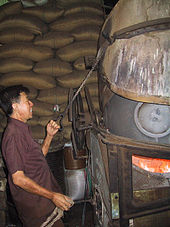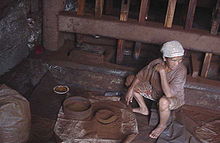- Coffee in Indonesia
-
Indonesia is currently the fourth largest producer of coffee in the world. Coffee in Indonesia began with its colonial history, and has played an important part in the growth of the country. Indonesia is located within an ideal geography for coffee plantations. The longitude and latitude of the country means that the island origins are all well suited micro-climates for the growth and production of coffee, resulting in widespread environmental degradation and the destruction of tropical rainforests that have the highest concentration of endemic species in the world.
Contents
Origins
In the early days, the prominent coffee under Dutch rule was Coffea arabica. The coffee was introduced to the archipelago via Ceylon (modern day Sri Lanka). The Dutch Colonial Government initially planted coffee around Batavia (Jakarta), and as far south as Sukabumi and Bogor, in the 17th century. Coffee plantations were also established in East Java, Central Java, West Java and in parts of Sumatra and Sulawesi. Coffee at the time was also grown in East Indonesia- East Timor and Flores. Both of these islands were originally under Portuguese control and the coffee was also C. arabica, but from different root stocks. The coffee in Eastern Indonesia was not affected to the same degree by rust, and even today, some coffee in East Timor can be traced back to the 16th and 17th century.
A rust plague in the late 1880s killed off much of the plantation stocks in Sukabumi, before spreading to Central Java and parts of East Java. Around the turn of the century the C. arabica crops were devastated by coffee rust, wiping out the bulk of the Dutch root-stocks. The Dutch responded by replacing the C. arabica firstly with Coffea liberica (a tough, but somewhat unpalatable coffee) and later with Coffea canephora. The popularity of this species was short lived as it was also affected by disease. The C. liberica cherry can still be found throughout Java, but is seldom used as a commercial crop in Indonesia. The C. liberica bean is much larger than either C. arabica or the C. canephora cherry; however, it shares more in common cupping wise with C. canephora.
Current status of the industry
C. canephora replaced C. liberica and is still the stock crop today. It is not the coffee Indonesia is famous for, but makes up some 88% of exports from the country.
Disaster (disease and natural), World War II and the struggle for independence all played a big part in the changes that are seen in Indonesian coffee today. In the early part of the 20th century, the coffee industry was controlled by Dutch plantation owners and the colonial government. Infrastructure was developed in East and Central Java in particular to make the shipping of commodities such as coffee as easy as possible. Prior to World War II, Central Java in particular had a very strong rail transportation system that brought coffee, sugar, pepper, tea and tobacco out of the province to the port city of Semarang. Coffee in Central Java was primarily C. canephora, while the government estates (Kayu Mas, Blewan, Jampit) in East Java were C. arabica. The mountain area stretching from Jember in East Java through to the port of Banyuwangi was heavily planted in both C. arabica and C. canephora. C. arabica was farmed on plantations at higher elevations, while C. canephora was grown at lower elevations.
In January 2007, the World Wide Fund for Nature (WWF) reported that land was illegally cleared for coffee farming in Bukit Barisan Selatan National Park on the island of Sumatra. The protected park is home to endangered tigers, elephants and rhinos, and WWF predicts that these species will be extinct in a decade should the clearing and farming continue. WWF states that the illegal coffee is sold to Western companies such as Nestlé and Kraft Foods.
After independence, the plantations throughout Indonesia either came under the control of the new government or were abandoned. Today close to 92% of coffee production is in the hands of small farmers or cooperatives.
Coffea canephora growing areas
C. canephora is grown at lower altitudes than C. arabica. The island of Sumatra is the largest producer, with the provinces of Lampung, South Sumatra and Bengkulu accounting for 75% of C. canephora production.[1] Smaller volumes are grown in Kalimantan, Sulawesi, Bali and Flores.
Coffea canephora production and processing
C. canephora is grown on small farms that average one hectare. The crop is harvested by stripping off all the fruit on the branch, resulting in a mix of ripe and green cherries. The unripe cherries are one reason that C. canephora coffee tastes bitter. Farmers dry the coffee cherries whole, for up to three weeks. After the drying, the dry cherries are hulled. Farmers sell the cherries to collectors, who sell them to the exporters. The exporters dry the crop to 12 to 13% moisture, and it is then sorted and graded. Exports are usually made in break bulk shipments, rather than in containers as with C. arabica.
A small portion of the crop is harvested and processed more like C. arabica. Only ripe cherries are harvested and these are processed by washing. Prices for "fully washed" C. canephora are close to C. arabica prices.
Markets for Indonesia's Coffea canephora
Most of Indonesia's C. canephora is used in instant coffee and other manufactured products. The domestic market consumes about 150,000 metric tons of C. canephora annually.[2] Export coffee is sold through the New York Coffee Exchange (NYCE). The main markets are the United States, western Europe and Japan. Demand from emerging markets such as Russia, China, Taiwan, South Korea and Malaysia is increasing.[3]
C. canephora is also an important part of traditional espresso blends, where it adds characteristic flavors and the all important crema on top of the coffee.
References
- ^ "Indonesian coffee supply". Indonesian Embassy. http://www.indonesia-ottawa.org/information/details.php?type=news_copy&id=897. Retrieved 2008-08-12.
- ^ "Indonesian Trade statistics". International Coffee Organization. http://www.ico.org/trade_statistics.asp. Retrieved 2008-08-12.
- ^ "Climate, demand boost coffee exports". Jakarta Post. http://www.thejakartapost.com/news/2008/07/14/climate-demand-boost-coffee-exports.html. Retrieved 2008-08-12.
- World Wildlife Fund Borneo & Sumatra Coffee Report
Categories:- Coffee production by country
- Economy of Indonesia
- Indonesian beverages
Wikimedia Foundation. 2010.


